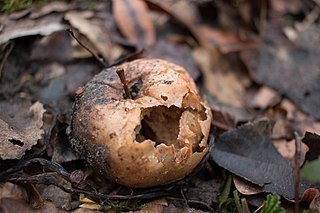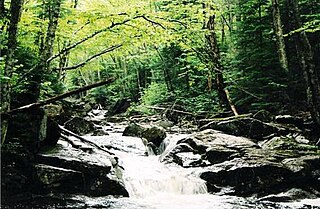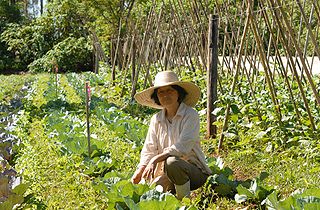Related Research Articles

Eutrophication, dystrophication or hypertrophication, is when a body of water becomes overly enriched with minerals and nutrients which induce excessive growth of algae. This process may result in oxygen depletion of the water body after the bacterial degradation of the algae. One example is an "algal bloom" or great increase of phytoplankton in a pond, lake, river or coastal zone as a response to increased levels of nutrients. Eutrophication is often induced by the discharge of nitrate or phosphate-containing detergents, fertilizers, or sewage into an aquatic system.

Biological control or biocontrol is a method of controlling pests such as insects, mites, weeds and plant diseases using other organisms. It relies on predation, parasitism, herbivory, or other natural mechanisms, but typically also involves an active human management role. It can be an important component of integrated pest management (IPM) programs.

Aphids are small sap-sucking insects and members of the superfamily Aphidoidea. Common names include greenfly and blackfly, although individuals within a species can vary widely in color. The group includes the fluffy white woolly aphids. A typical life cycle involves flightless females giving living birth to female nymphs—who may also be already pregnant, an adaptation scientists call telescopic development—without the involvement of males. Maturing rapidly, females breed profusely so that the number of these insects multiplies quickly. Winged females may develop later in the season, allowing the insects to colonize new plants. In temperate regions, a phase of sexual reproduction occurs in the autumn, with the insects often overwintering as eggs.

Hoverflies, also called flower flies or syrphid flies, make up the insect family Syrphidae. As their common name suggests, they are often seen hovering or nectaring at flowers; the adults of many species feed mainly on nectar and pollen, while the larvae (maggots) eat a wide range of foods. In some species, the larvae are saprotrophs, eating decaying plant and animal matter in the soil or in ponds and streams. In other species, the larvae are insectivores and prey on aphids, thrips, and other plant-sucking insects.

Decomposition is the process by which dead organic substances are broken down into simpler organic or inorganic matter such as carbon dioxide, water, simple sugars and mineral salts. The process is a part of the nutrient cycle and is essential for recycling the finite matter that occupies physical space in the biosphere. Bodies of living organisms begin to decompose shortly after death. Animals, such as worms, also help decompose the organic materials. Organisms that do this are known as decomposers. Although no two organisms decompose in the same way, they all undergo the same sequential stages of decomposition. The science which studies decomposition is generally referred to as taphonomy from the Greek word taphos, meaning tomb. Decomposition can also be a gradual process for organisms that have extended periods of dormancy.

The Hemiptera or true bugs are an order of insects comprising some 50,000 to 80,000 species of groups such as the cicadas, aphids, planthoppers, leafhoppers, bed bugs and shield bugs. They range in size from 1 mm (0.04 in) to around 15 cm (6 in), and share a common arrangement of sucking mouthparts. The name "true bugs" is often limited to the suborder Heteroptera. Many insects commonly known as "bugs", especially in American English, belong to other orders; for example, the lovebug is a fly and the May bug and ladybug are beetles.

Ecosystem ecology is the integrated study of living (biotic) and non-living (abiotic) components of ecosystems and their interactions within an ecosystem framework. This science examines how ecosystems work and relates this to their components such as chemicals, bedrock, soil, plants, and animals.

Adalia bipunctata, the two-spot ladybird, two-spotted ladybug or two-spotted lady beetle, is a carnivorous beetle of the family Coccinellidae that is found throughout the holarctic region. It is very common in western and central Europe. It is also native to North America but it has heavily declined in many states and provinces. It is commonly introduced and imported as a biological control agent.
In agriculture and gardening, a beneficial organism is any organism that benefits the growing process, including insects, arachnids, other animals, plants, bacteria, fungi, viruses, and nematodes. Benefits include pest control, pollination, and maintenance of soil health. The opposite of beneficial organisms are pests, which are organisms deemed detrimental to the growing process. There are many different types of beneficial organisms as well as beneficial microorganisms. Also, microorganisms have things like salt and sugar in them. Beneficial organisms include but are not limited to: Birds, Bears, Nematodes, Insects, Arachnids, and fungi. The ways that birds and bears are considered beneficial is mainly because they consume seeds from plant and spread them through feces. Birds also prey on certain insects that eat plants and hinder them from growing these insects are known as non beneficial organisms. Nematodes are considered beneficial because they will help compost and provide nutrients for the soil the plants are growing in. Insects and arachnids help the growing process because they prey on non beneficial organisms that consume plants for food. Fungi help the growing process by using long threads of mycelium that can reach very long distances away from the tree or plant and bring water and nutrients back to the tree or plant roots.

Ecological stoichiometry considers how the balance of energy and elements influences living systems. Similar to chemical stoichiometry, ecological stoichiometry is founded on constraints of mass balance as they apply to organisms and their interactions in ecosystems. Specifically, how does the balance of energy and elements affect and how is this balance affected by organisms and their interactions. Concepts of ecological stoichiometry have a long history in ecology with early references to the constraints of mass balance made by Liebig, Lotka, and Redfield. These earlier concepts have been extended to explicitly link the elemental physiology of organisms to their food web interactions and ecosystem function.

Coccinella septempunctata, the seven-spot ladybird, is the most common ladybird in Europe. Its elytra are of a red colour, but punctuated with three black spots each, with one further spot being spread over the junction of the two, making a total of seven spots, from which the species derives both its common and scientific names.
Herbivores are dependent on plants for food, and have coevolved mechanisms to obtain this food despite the evolution of a diverse arsenal of plant defenses against herbivory. Herbivore adaptations to plant defense have been likened to "offensive traits" and consist of those traits that allow for increased feeding and use of a host. Plants, on the other hand, protect their resources for use in growth and reproduction, by limiting the ability of herbivores to eat them. Relationships between herbivores and their host plants often results in reciprocal evolutionary change. When a herbivore eats a plant it selects for plants that can mount a defensive response, whether the response is incorporated biochemically or physically, or induced as a counterattack. In cases where this relationship demonstrates "specificity", and "reciprocity", the species are thought to have coevolved. The escape and radiation mechanisms for coevolution, presents the idea that adaptations in herbivores and their host plants, has been the driving force behind speciation. The coevolution that occurs between plants and herbivores that ultimately results in the speciation of both can be further explained by the Red Queen hypothesis. This hypothesis states that competitive success and failure evolve back and forth through organizational learning. The act of an organism facing competition with another organism ultimately leads to an increase in the organism's performance due to selection. This increase in competitive success then forces the competing organism to increase its performance through selection as well, thus creating an "arms race" between the two species. Herbivores evolve due to plant defenses because plants must increase their competitive performance first due to herbivore competitive success.
Soil ecology is the study of the interactions among soil biology, and between biotic and abiotic aspects of the soil environment. It is particularly concerned with the cycling of nutrients, formation and stabilization of the pore structure, the spread and vitality of pathogens, and the biodiversity of this rich biological community.

The phosphorus cycle is the biogeochemical cycle that describes the movement of phosphorus through the lithosphere, hydrosphere, and biosphere. Unlike many other biogeochemical cycles, the atmosphere does not play a significant role in the movement of phosphorus, because phosphorus and phosphorus-based compounds are usually solids at the typical ranges of temperature and pressure found on Earth. The production of phosphine gas occurs in only specialized, local conditions. Therefore, the phosphorus cycle should be viewed from whole Earth system and then specifically focused on the cycle in terrestrial and aquatic systems.

Carnivorous plants are plants that derive some or most of their nutrients from trapping and consuming animals or protozoans, typically insects and other arthropods. However, carnivorous plants generate energy from photosynthesis. Carnivorous plants have adapted to grow in places where the soil is thin or poor in nutrients, especially nitrogen, such as acidic bogs. Charles Darwin wrote Insectivorous Plants, the first well-known treatise on carnivorous plants, in 1875. Carnivorous plants can be found on all continents except Antarctica, as well as many Pacific islands.

Coccinellidae is a widespread family of small beetles ranging in size from 0.8 to 18 mm. The family is commonly known as ladybugs in North America and ladybirds in Britain and other parts of the English-speaking world. Entomologists prefer the names ladybird beetles or lady beetles as these insects are not classified as true bugs.

Syritta pipiens, sometimes called the thick-legged hoverfly, is one of the most common species in the insect family Syrphidae. This fly originates from Europe and is currently distributed across Eurasia and North America. They are fast and nimble fliers, and their larvae are found in wet, rotting organic matter such as garden compost, manure, and silage. The species is also commonly found in human-created environments such as most farmland, gardens, and urban parks, wherever there are flowers. This species is an important part of its native ecosystem as adult Syritta pipiens flies are critical pollinators for a variety of flowering plants and the species supports parasitism by various parasitic wasp species. Thus, they play an important role in environmental functionality, and can serve as bio-indicators, in which their abundance can reflect the health of the environment. They can also serve as a biological control agent against pests such as lettuce aphids.

Myzus persicae, known as the green peach aphid, greenfly, or the peach-potato aphid, is a small green aphid. It is the most significant aphid pest of peach trees, causing decreased growth, shrivelling of the leaves and the death of various tissues. It is also acts as a vector for the transport of plant viruses such as cucumber mosaic virus (CMV), potato virus Y (PVY) and tobacco etch virus (TEV). Potato virus Y and potato leafroll virus can be passed to members of the nightshade/potato family (Solanaceae), and various mosaic viruses to many other food crops.

A nutrient cycle is the movement and exchange of organic and inorganic matter back into the production of matter. Energy flow is a unidirectional and noncyclic pathway, whereas the movement of mineral nutrients is cyclic. Mineral cycles include the carbon cycle, sulfur cycle, nitrogen cycle, water cycle, phosphorus cycle, oxygen cycle, among others that continually recycle along with other mineral nutrients into productive ecological nutrition.

Hugh David Loxdale is an entomologist. He was professor of ecology at the Institute of Ecology, University of Jena from 2009 to 2010, president of the Royal Entomological Society from 2004 to 2006, and honorary visiting professor at the School of Biosciences, Cardiff University. Loxdale works on the population biology, ecology, and genetics of insects, especially aphids and their wasp parasitoids.
References
- ↑ Insects and plants: parallel evolution and adaptations - Page 29 Pierre Jolivet - 1986 "Xenophagy is a complete change in diet, the herbivorous diet becoming carnivorous or vice versa, predators becoming necrophagous, coprophages becoming necrophagous or carnivorous, and so on."
- ↑ Sven Erik Jørgensen Encyclopedia of Ecology: P-S Page 2924 2008 "Allotrophy is also widespread among insects, an example being the 7-spot ladybird, whose diet is mainly based on aphids (plant lice) but often includes pollen, too."
- ↑ Israel journal of entomology Volumes 12-14 - Page 138 Entomological Society of Israel - 1978 "Jolivet (1953, 1967, and in litt., 1976) has used the term allotrophy for the cases where a beetle is found to feed on a completely unrelated host from its normally ... There are several apparent cases of allotrophy in Israeli Longitarsus (Table 1). "
- ↑ Fernando E. Vega, Harry K. Kaya Insect Pathology Page 470 - 2012 "The process whereby the cell directs its autophagy machinery toward killing pathogens is termed xenophagy (Levine, 2005). Xenophagy is thought to play a role in antiviral defenses (Sabin et al., 2010), although there are few data on these interactions. While the specific molecules controlling this process are poorly understood, they are expected to share similarities ..."
- ↑ Diane Elizabeth Alexander, Multiple functions of the herpes simplex virus type 1 Page 86 Washington University in St. Louis - 2008 "Xenophagy is proving to be an important component of the innate immune response to viral infections. Neuronal expression of the mammalian autophagy promoting protein Beclin 1 protects mice against lethal Sindbis virus encephalitis "
- ↑ John P. Greer, John Foerster, George M. Rodgers Wintrobe's Clinical Hematology Volume 2 - Page 271 2008 "The general importance of xenophagy is not yet certain. Among the key components that are transferred to the phagosome and are critical in creating an antimicrobial environment are the vacuole ATPase, NOS2, and phagocyte oxidase ..."
- ↑ Issues in Biological, Biochemical, and Evolutionary Sciences "We also find that the invasive efficiency of group A Streptococcus into cells is not altered by knockdown of VAMP8 or Vti1b, whereas cellular bactericidal efficiency is significantly diminished, indicating that xenophagy is functionally impaired."
- ↑ Baruch Velan, Avigdor Shafferman, Arie Ordentlich -The Challenge of Highly Pathogenic Microorganisms Page 31 2010 "Furthermore, studies have shown the ability of Y. pestis to survive in macrophages activated with the cytokine IFNγ. Some vacuolar pathogens appear to co-opt the process of autophagy for survival in host cells. Alternatively, xenophagy is an ..."
- ↑ Eutrophication: causes, consequences, correctives Page 53 National Academy of Sciences (U.S.) - 1969 "The allotrophy of a lake indicates the intensity of organic supply from its environment. According to the first statement, trophy should not be equated with the status of nutrient conditions, as advocated by Findenegg (1955)."
- ↑ Handbook of Inland Aquatic Ecosystem Management - Page 16 Sven Erik Jorgensen, Jose Galizia Tundisi, Takako Matsumura Tundisi - 2012 (L 1 ) “Allotrophy” (heterotrophic pathway) “Autotrophy” (autotrophic pathway)
- ↑ Productivity of world ecosystems Page 90 International Council of Scientific Unions. Special Committee for the International Biological Programme - 1975 "DEGREE OF ALLOTROPHY IN STREAMS The role of allochthonous organic matter in stream economy was ... However, the measurement of the degree of allotrophy has been attempted only recently and by a few stream ecologists.
- ↑ Academic Press Dictionary of Science and Technology- Page 80 Christopher G. Morris, Academic Press - 1992 "Thus, allotroph, allotrophy. allotrophic lake Ecology, a lake that receives organic material by drainage from the surrounding land. allotropic relating to or characterized by allotropy. Also, ALLOTROPHIC. allotropy Chemistry, the property ..."
